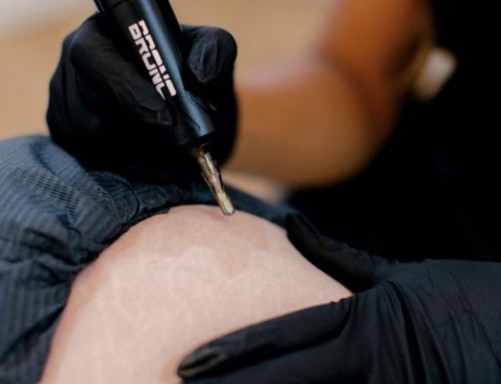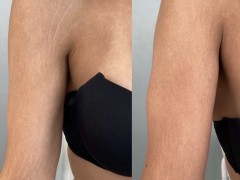Inkless Stretch Mark Revision (ISR) is an advanced skin rejuvenation technique that improves the appearance of stretch marks without adding pigment. Unlike camouflage tattooing, which blends stretch marks with surrounding skin tones using ink, ISR works by stimulating natural healing through microneedling and the infusion of custom-formulated serums containing vitamins, peptides, and healing agents. This process encourages collagen production, skin repair, and increased elasticity, resulting in smoother, more even-toned skin over time.
As a certified artist trained in NUE Conceal, I specialize in advanced ISR techniques to help restore confidence in your skin. The procedure is relatively painless, and no numbing cream is needed, making it a comfortable and effective solution for all skin types.
It lasts from 1–5 years or even longer, depending on your skin type and lifestyle
Duration: 2–3 hours depending on the area.
Pricing: $650 per area. Each session after that $400

- Non-Invasive: No needles or pigmentation are used, making it a gentle procedure with minimal risk.
- Improves Skin Texture: The treatment encourages collagen production, which helps smooth out the skin’s texture.
- Fades Stretch Marks: Reduces the visibility of stretch marks, blending them with the surrounding skin for a more uniform appearance.
- Safe for Sensitive Areas: Can be performed on various areas of the body, including the abdomen, thighs, hips, and arms.
- Minimal Downtime: Most people experience little to no downtime and can resume daily activities shortly after treatment.
- Natural-Looking Results: The treatment promotes a gradual improvement, creating natural-looking results without harsh lines or color discrepancies.
- Long-Term Results: With proper aftercare, the results are long-lasting and may require fewer touch-ups over time.
Inkless Stretch Marks Revision works best on:
- Dark stretch marks/Light stretch marks (at least 3 month old)
- Deep or indented stretch marks
- Stretch marks caused by pregnancy, rapid weight changes, or growth spurts
- Those seeking a non-invasive treatment
- Who wants to return confidence in skin
- Anyone looking to improve skin texture and tone
By following these pre-care steps, you’re giving your skin the best chance to heal beautifully—with longer-lasting results and smoother texture after your inkless stretch mark revision treatment.
4 Weeks Before Your Appointment:
• Avoid laser treatments, microneedling, or aggressive exfoliation on the area.
• Stay out of tanning beds and limit sun exposure—skin must not be sunburned or irritated.
2 Weeks Before Your Appointment:
• Stop using retinol, glycolic acid, or other exfoliating products on the treatment area.
• No self-tanning lotions or sprays on the area.
1 Week Before Your Appointment:
• Keep the area moisturized daily for better skin elasticity.
• Avoid scheduling any facials, peels, or skin treatments in the area.
24-48 Hours Before Your Appointment:
• No alcohol, caffeine, or blood-thinning medications (unless prescribed by a doctor) to minimize sensitivity and bruising.
• Avoid intense workouts that may increase inflammation in the skin.
• If necessary, shave the area at least 24 hours before to prevent irritation.
• No Fish oil or Vitamin E one week prior to procedure.
• Do not tan or have a sunburned face/body the day of procedure
Day of the Procedure
• Shower before your appointment, as you’ll need to avoid getting the treated area wet for 24 hours afterward.
• Do not apply lotions, oils, or perfumes on the treatment area.
• Eat a light meal before arriving to avoid feeling lightheaded during the procedure.
• Arrive with clean skin—no makeup, deodorant, or products on the area being treated.
• Wear loose, comfortable clothing that allows easy access to the treatment area and won’t rub against your skin post-procedure.
1. Consultation: A thorough discussion to understand your skin concerns and goals
2. Preparation: Your safety is my top priority. The treatment area is cleaned and prepped using sterile techniques to ensure a safe and hygienic environment.
3. Numbing (if needed): Numbing cream is typically not necessary, as the procedure is generally not painful.
4. Application: Using disposable needles at a precise depth of 0.5-1 mm, stretch marks are treated to stimulate collagen production and healing.
5. Post-Treatment Care: Detailed aftercare instructions are provided to support healing and maximize results.
6. Touch-Up Session: A follow-up session may be required after hypopigmentation has fully faded, typically several weeks to a few months post-treatment.






To prevent any infection, please take your time to read and follow this aftercare.
Dry the area with toilet paper or a fresh, clean towel.
Apply ointment (Vaseline or Aquaphor) 2x per day for 8 weeks (or until your next treatment).
Protect the treated area by always wearing clean, loose shirt/jogging pants.
Removing scabs
Taking immersion baths (swimming pool, beach, bathtub)
Going to saunas
Allowing excessive sweating (workout)
Exposing the area to excessive heat and suffocation (tight clothes)
- THINGS TO AVOID:
- No saltwater, no exfoliation, no laser hair removal or waxing on areas for 14 days
- 1st 30 days, do not use sunscreen, sunblock, self-tanning or any substance that contains vitamin D
- Do not shower with hot water as it may cause irritation for the first few days.
- Do not take vitamin D pills
- If there is any allergic reaction, please call your physician
- Sunbathing is strictly forbidden for the next 30 days.
The treated area may appear red and swollen immediately after the treatment.
After 24 hours, the swelling will subside, but the redness may persist for up to 72 hours.
Following 72 hours, the redness will gradually transition to a brownish tone (hyperpigmentation).
Hyperpigmentation might persist for a period ranging from one to three months.
If the treatment was performed on the legs, the healing process may extend up to six months, especially for individuals with darker complexions.
Please refrain from being alarmed if the hyperpigmentation takes some time to fade; this is a normal part of the skin's healing process. To expedite healing, it's advisable to avoid foods and beverages high in sugar, as elevated sugar levels can prolong the healing process. Instead, focus on consuming vegetables, as many of them possess healing properties (consult your doctor if you have any underlying medical conditions).
Smoking can also impede the healing process.
Does ISR work?
ISR treatment is known to generate great and fast results. You will notice almost 50-100% improvement just after the first session. However, you might require some additional sessions to reach your goal.
How long does the procedure take?
The length of the treatment depends on the size of the area to be treated. On average, a small area around 1 hour and a bigger area up to 3 hours
How quickly will I see the results after a treatment?
30 to 90 days after your initial treatment.

-240x180.JPG)
-240x180.JPG)





